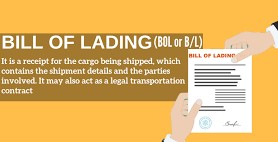Bill of lading in shipping is a legal document that contains every detail like the type, quantity and destination of the goods that is being carried in the ship. This document is used and shared between the ship owner and the carrier and contains all the above specifications in detail. When the carrier delivers goods at the decided destination, the bill also acts as a receipt. Authorised people from both the carrier and the shipper are present to sign the bill so that there are no confusions later. This bill does not consider the mode of transportation and only specifies the details of the shipped goods. This is not taught in import export courses online so this article might be extremely helpful for you if you want to learn everything about this bill.
Why is bill of lading necessary
It is not necessary for the carrier to submit all originals prior to delivery. The exporter must keep ownership of the entire set of originals until payment is received, a bill of exchange is acknowledged, or some other form of payment guarantee is provided which is necessary to secure the payments. As a result, while shipping, a bill of lading is essential. The bill serves as a contract between a carrier and a shipper for the transportation of goods, as well as a receipt provided by a carrier to the shipper under certain conditions.
Types of Bill of Lading
- Clean Bill of Lading
It is issued by the Shipping Company or its agents without making any declarations about the faulty condition of the goods/packages brought on board/stuffed in containers.
- Received for Shipment Bill of Lading
This bill acts as a receipt against the receiving of goods of shipment and is issued by the carrier.
- Through Bill of Lading
This bill acts like a permission for the shipping carrier to pass the shipment through multiple modes of transportation or distribution centres
- Claused Bill of Lading
In cases where either the quantity of goods goes missing or the shipment is damaged, this bill is issued
- Container Bill of Lading
It gives information related to goods that are delivered in a safe container.
- House Bill of Lading
When the cargo is received, the document is provided to the suppliers as an acknowledgement of receipt of items that have been shipped.
- Master Bill of Lading
These bills are created for the shipping companies by their carriers and acts as a receipt of transfer
- Charter Party Bill of Lading
The charterer of the vessel issues the paperwork to the shipper for the items that are shipped on board in the vessel.
- Multimodal Transport Document/ Combined Transport Document
This is a type of through bill that involves a minimum of 2 modes of transportation, land or ocean.
- Stale Bill of Lading
After 21 days from the date of shipping, or any other date/number of days specified in the documentary credit, this Bill is offered for negotiation.
- Short-term/ Blank Back Bill of Lading
When the detailed terms and conditions of the carrier contract are not specified, this bill is issued
- Straight Bill of Lading
The commodities are committed to a specific individual, and the Straight Bill of Lading is not negotiable free of existing equities.
- Order Bill of Lading
This bill expresses words that make the bill negotiable.
- Bearer Bill of Lading
This bill states that the delivery must be done to somebody who holds this bill
- Surrender Bill of Lading
It works under import documentary credit where the bank releases documents after receiving the receipt from the negotiating bank

